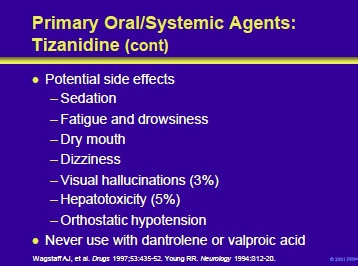
Tizanidine side effects include sedation, fatigue, drowsiness, dry mouth, dizziness and orthostatic hypotension. While the latter is less common than that seen with clonidine, the risk is real. Patients requiring this medicine who experience orthostatic hypotension can be treated with a mineralocorticoid such as fludrocortisone acetate. Other side effects include visual hallucinations (3%) and hepatotoxicity (5%).
Because of the risk of liver injury, tizanidine should not be used in conjunction with either dantrolene or valproate as well as other medications that are metabolized through the liver.
The current practice is to monitor LFTs at baseline, 6 weeks, 3 months and 6 months after therapy is started. Some clinicians will then continue to monitor liver function periodically thereafter.
Wagstaff AJ, Bryson HM. Tizanidine: a review of its pharmacology, clinical efficacy and tolerability in the management of spasticity associated with cerebral and spinal disorders. Drugs 1997;53:435-52. Young RR. Spasticity: a review. Neurology 1994:(suppl 9):S12- 20.
Article Index
- 5. Oral Medications for the Treatment of Spasticity
- Physiologic Basis of Antispasticity Medications
- Spinal Effector Mechanisms
- Myotactic Reflex
- Primary and Secondary Antispasticity Drugs
- Primary Oral/Systemic Agents: Diazepam
- Primary Oral/Systemic Agents: Diazepam (cont)
- Primary Oral/Systemic Agents: Diazepam (cont)
- Primary Oral/Systemic Agents: Baclofen
- Primary Oral/Systemic Agents: Baclofen (cont)
- Primary Oral/Systemic Agents: Baclofen (cont)
- Primary Oral/Systemic Agents: Dantrolene
- Primary Oral/Systemic Agents: Dantrolene (cont)
- Primary Oral/Systemic Agents: Dantrolene (cont)
- Primary Oral/Systemic Agents: Tizanidine
- Primary Oral/Systemic Agents: Tizanidine (cont)
- Primary Oral/Systemic Agents: Tizanidine (cont)
- Secondary Oral/Systemic Agents
- All Pages
Page 17 of 18

